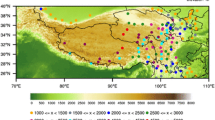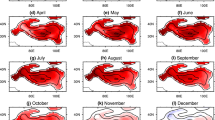Abstract
Based on regular surface meteorological observations and NCEP/DOE reanalysis data, this study investigates the evolution of surface sensible heat (SH) over the central and eastern Tibetan Plateau (CE-TP) under the recent global warming hiatus. The results reveal that the SH over the CE-TP presents a recovery since the slowdown of the global warming. The restored surface wind speed together with increased difference in ground-air temperature contribute to the recovery in SH. During the global warming hiatus, the persistent weakening wind speed is alleviated due to the variation of the meridional temperature gradient. Meanwhile, the ground surface temperature and the difference in ground-air temperature show a significant increasing trend in that period caused by the increased total cloud amount, especially at night. At nighttime, the increased total cloud cover reduces the surface effective radiation via a strengthening of atmospheric counter radiation and subsequently brings about a clear upward trend in ground surface temperature and the difference in ground-air temperature. Cloud–radiation feedback plays a significant role in the evolution of the surface temperature and even SH during the global warming hiatus. Consequently, besides the surface wind speed, the difference in ground-air temperature becomes another significant factor for the variation in SH since the slowdown of global warming, particularly at night.
摘要
本文利用常规地面气象观测资料及NCEP/DOE再分析数据集, 探讨了青藏高原中东部地区地表感热在全球变暖停滞期的演变. 结果表明: 高原中东部地区自1980年代后持续减弱的地表感热在全球变暖停滞期有所恢复; 高原感热的这一变化主要由地表风速的减弱停滞及地气温差的增加导致; 在全球变暖停滞期, 一方面, 东亚中高纬地区经向温度梯度的改变使前期持续减弱的高原地表风速有所恢复, 另一方面, 夜间总云量的增加通过加强大气逆辐射, 减弱地面有效辐射, 进而导致地温及地气温差的显著增加. 全球变暖停滞期云-辐射反馈效应在高原温度乃至感热的变化中具有重要的作用, 该期间地气温差(尤其是夜间的地气温差)的变化是除地表风速以外影响高原感热变化的另一重要因素.
Similar content being viewed by others
References
Berthier, E., and T. Toutin, 2008: SPOT5-HRS digital elevation models and the monitoring of glacier elevation changes in North-West Canada and South-East Alaska. Remote Sensing of Environment, 112(5), 2443–2454, doi: 10.1016/j.rse.2007.11.004.
Chen, B., W. C. Chao, and X. Liu, 2003: Enhanced climatic warming in the Tibetan Plateau due to doubling CO2: A model study. Climate Dyn., 20(4), 401–413, doi: 10.1007/s00382-002-0282-4.
Chen, J. H., X. Q. Wu, Y. Yin, and H. Xiao, 2015: Characteristics of heat sources and clouds over eastern China and the Tibetan Plateau in boreal summer. J. Climate, 28, 7279–7296, doi: 10.1175/JCLI-D-14-00859.1.
Chen, L. X., E. R. Reiter, and Z. Q. Feng, 1985: The atmospheric heat source over the Tibetan Plateau: May–August 1979. Mon. Wea. Rev., 113, 1771–1790, doi: 10.1175/1520-0493(1985)113<1771:TAHSOT>2.0.CO;2.
Dai, A. G., J. C. Fyfe, S. P. Xie, and X. G. Dai, 2015: Decadal modulation of global surface temperature by internal climate variability. Nature Climate Change, 5, 555–559, doi: 10.1038/nclimate2605.
Duan, A. M., and G. X. Wu, 2005: Role of the Tibetan Plateau thermal forcing in the summer climate patterns over subtropical Asia. Climate Dyn., 24, 793–807, doi: 10.1007/s00382-004-0488-8.
Duan, A. M., and G. X. Wu, 2006: Change of cloud amount and the climate warming on the Tibetan Plateau. Geophys. Res. Lett., 33(22), L22704, doi: 10.1029/2006GL027946.
Duan, A. M., and Z. X. Xiao, 2015: Does the climate warming hiatus exist over the Tibetan Plateau? Scientific Reports, 5, 13711, doi: 10.1038/srep13711.
Duan, A. M., and G. X. Wu, 2008: Weakening trend in the atmospheric heat source over the Tibetan Plateau during recent decades. Part I: Observations. J. Climate, 21, 3149–3164, doi: 10.1175/2007JCLI1912.1.
Duan, A. M., and G. X. Wu, 2009: Weakening trend in the atmospheric heat source over the Tibetan Plateau during recent decades. Part II: Connection with climate warming. J. Climate, 22, 4197–4212, doi: 10.1175/2009JCLI2699.1.
Duan, A. M., G. X. Wu, Q. Zhang, and Y. M. Liu, 2006: New proofs of the recent climate warming over the Tibetan Plateau as a result of the increasing greenhouse gases emissions. Chinese Science Bulletin, 51, 1396–1400, doi: 10.1007/s11434-006-1396-6.
Duan, A. M., F. Li, M. R. Wang, and G. X. Wu, 2011: Persistent weakening trend in the spring sensible heat source over the Tibetan Plateau and its impact on the Asian summer monsoon. J. Climate, 24, 5671–5682, doi: 10.1175/JCLI-D-11-00052.1.
Duan, A. M., G. X. Wu, Y. M. Liu, Y. M. Ma, and P. Zhao, 2012: Weather and climate effects of the Tibetan Plateau. Adv. Atmos. Sci., 29(5), 978–992, doi: 10.1007/s00376-012-1220-y.
Duan, A. M., M. R. Wang, Y. H. Lei, and Y. F. Cui, 2013: Trends in Summer Rainfall over China Associated with the Tibetan Plateau Sensible Heat Source during 1980-2008. J. Climate, 26, 261–275, doi: 10.1175/JCLI-D-11-00669.1.
Easterling, D. R., and M. F. Wehner, 2009: Is the climate warming or cooling? Geophys. Res. Lett., 36, L08706, doi: 10.1029/2009GL037810.
Easterling, D. R., and Coauthors, 1997: Maximum and minimum temperature trends for the globe. Science, 277, 364–367, doi: 10.1126/science.277.5324.364.
England, M. H., and Coauthors, 2014: Recent intensification of wind-driven circulation in the Pacific and the ongoing warming hiatus. Nature Climate Change, 4, 222–227, doi: 10.1038/nclimate2106.
Fyfe, J. C., K. von Salzen, J. N. S. Cole, N. P. Gillett, and J.-P. Vernier, 2013a: Surface response to stratospheric aerosol changes in a coupled atmosphere-ocean model. Geophys. Res. Lett., 40, 584–588, doi: 10.1002/grl.50156.
Fyfe, J. C., N. P. Gillett, and F. W. Zwiers, 2013b: Overestimated global warming over the past 20 years. Nature Climate Change, 3, 767–769, doi: 10.1038/nclimate1972.
Giorgi, F., J. W. Hurrell, M. R. Marinucci, and M. Beniston, 1997: Elevation dependency of the surface climate change signal: A model study. J. Climate, 10(2), 288–296, doi: 10.1175/1520-0442(1997)010<0288:EDOTSC>2.0.CO;2.
Guo, X. F., K. Yang, and Y. Y. Chen, 2011: Weakening sensible heat source over the Tibetan Plateau revisited: effects of the land–atmosphere thermal coupling. Theor. Appl. Climatol., 104(1–2), 1–12, doi: 10.1007/s00704-010-0328-1.
Hu, J., and A. M. Duan, 2015: Relative contributions of the Tibetan Plateau thermal forcing and the Indian Ocean Sea surface temperature basin mode to the interannual variability of the East Asian summer monsoon. Climate Dyn., 45, 2697–2711, doi: 10.1007/s00382-015-2503-7.
Karl, T. R., G. Kukla, V. N. Razuvayev, M. J. Changery, R. G. Quayle, R. R. Heim Jr., D. R. Easterling, and C. B. Fu, 1991: Global warming: Evidence for asymmetric diurnal temperature change. Geophys. Res. Lett., 18, 2253–2256, doi: 10.1029/91GL02900.
Karl, T. R., and Coauthors, 1993: A new perspective on recent global warming: Asymmetric trends of daily maximum and minimum temperature. Bull. Amer. Meteor. Soc., 74, 1007–1023, doi: 10.1175/1520-0477(1993)074<1007:ANPORG>2.0.CO;2.
Kosaka, Y., and S. P. Xie, 2013: Recent global-warming hiatus tied to equatorial Pacific surface cooling. Nature, 501, 403–407, doi: 10.1038/nature12534.
Li, C. F., and M. Yanai, 1996: The onset and interannual variability of the Asian summer monsoon in relation to land-sea thermal contrast. J. Climate, 9, 358–375, doi: 10.1175/1520-0442(1996)009<0358:TOAIVO>2.0.CO;2.
Li, W. P., G. X. Wu, Y. M. Liu, and X. Liu, 2001: How the surface processes over the Tibetan Plateau affect the summertime Tibetan Anticyclone-numerical experiments. Chinese Journal of Atmospheric Sciences, 25, 809–816, doi: 10.3878/j.issn.1006-9895.2001.06.08. (in Chinese with English abstract)
Lin, C. G., K. Yang, J. Qin, and R. Fu, 2013: Observed coherent trends of surface and upper-air wind speed over China since 1960. J. Climate, 26(9), 2891–2903, doi: 10.1175/JCLI-D-12-00093.1.
Liu, X. D., Z. G. Cheng, L. B. Yan, and Z. Y. Yin, 2009: Elevation dependency of recent and future minimum surface air temperature trends in the Tibetan Plateau and its surroundings. Global and Planetary Change, 68(3), 164–174, doi: 10.1016/j.gloplacha.2009.03.017.
Meehl, G. A., J. M. Arblaster, J. T. Fasullo, A. X. Hu, and K. E. Trenberth, 2011: Model-based evidence of deep-ocean heat uptake during surface-temperature hiatus periods. Nature Climate Change, 1, 360–364, doi: 10.1038/nclimate1229.
Rangwala, I., E. Sinsky, and J. R. Miller, 2013: Amplified warming projections for high altitude regions of the northern hemisphere mid-latitudes from CMIP5 models. Environmental Research Letters, 8, 024040, doi: 10.1088/1748-9326/8/2/024040.
Santer, B. D., and Coauthors, 2011: Separating signal and noise in atmospheric temperature changes: The importance of timescale. J. Geophy. Res., 116, D22105, doi: 10.1029/2011 JD016263.
Santer, B. D., and Coauthors, 2013: Identifying human influences on atmospheric temperature. Proceedings of the National Academy of Sciences of the United States of America, 110, 26–33, doi: 10.1073/pnas.1210514109.
Santer, B. D., and Coauthors, 2014: Volcanic contribution to decadal changes in tropospheric temperature. Nature Geoscience, 7, 185–189, doi: 10.1038/ngeo2098.
Schmidt, G. A., D. T. Shindell, and K. Tsigaridis, 2014: Reconciling warming trends. Nature Geoscience, 7, 158–160, doi: 10.1038/ngeo2105.
Solomon, S., J. S. Daniell, R. R. Neely III, J.-P. Vernier, E. G. Dutton, and L. W. Thomason, 2011: The persistently variable “background” stratospheric aerosol layer and global climate change. Science, 333, 866–870, doi: 10.1126/science.1206027.
Trenberth, K. E., 2015: Has there been a hiatus? Science, 349, 691–692, doi: 10.1126/science.aac9225.
Wei, F. Y., 1999: Technology of Statistical Diagnosis and Prediction of Modern Climate. China Meteorological Press, Beijing, 296 pp. (in Chinese)
Wu, G. X., W.P. Li, H. Guo, 1997: Sensible heat driven air-pump over the Tibetan-Plateau and its impacts on the Asian Summer Monsoon. In: Ye DZ (ed) Collections on the Memory of Zhao Jiuzhang.Science Press, Beijing, pp 116–126.(in Chinese)
Wu, G. X., Y. M. Liu, J. Y. Mao, X. Liu, and W. P. Li, 2004: Adaptation of the atmospheric circulation to thermal forcing over the Tibetan Plateau. Observation, Theory and Modeling of Atmospheric Variability. Selected Papers of Nanjing Institute of Meteorology Alumni in Commemoration for Professor Jijia Zhang, X. Zhu, X. F. Li, and S. T. Zhou, Eds., World Scientific, 92–114, doi: 10.1142/9789812791139_0004.
Wu, G. X., Y. M. Liu, B. He, Q. Bao, A. M. Duan, and F. F. Jin, 2012: Thermal controls on the Asian summer monsoon. Scientific Reports, 2, 404, doi: 10.1038/srep00404.
Yanai, M., C. F. Li, and Z. S. Song, 1992: Seasonal heating of the Tibetan Plateau and its effects on the evolution of the Asian summer monsoon. J. Meteor. Soc. Japan, 70, 319–351, doi: 10.2151/jmsj1965.70.1B 319.
Yang, K., X. F. Guo, He J., J. Qin, and T. Koike, 2011a: On the climatology and trend of the atmospheric heat source over the Tibetan Plateau: An experiments-supported revisit. J. Climate, 24, 1525–1541, doi: 10.1175/2010JCLI3848.1.
Yang, K., X. F. Guo, and B. Y. Wu, 2011b: Recent trends in surface sensible heat flux on the Tibetan Plateau. Science China Earth Sciences, 54, 19–28, doi: 10.1007/s11430-010-4036-6.
Yang, K., B. H. Ding, J. Qin, W. J. Tang, N. Lu, and C. G. Lin, 2012: Can aerosol loading explain the solar dimming over the Tibetan Plateau? Geophys. Res. Lett., 39, L20710, doi: 10.1029/2012GL053733.
Ye, D. Z., and G. X. Wu, 1998: The role of the heat source of the Tibetan Plateau in the general circulation. Meteor. Atmos. Phys., 67(1–4), 181–198, doi: 10.1007/BF01277509.
Yeh, T. C., and Y. X. Gao, 1979: Qinghai-Xizang Plateau Meteorology. Science Press, Beijing, 1–278. (in Chinese)
Yeh, T. C., S. W. Lo, and P. C. Chu, 1957: The wind structure and heat balance in the lower troposphere over Tibetan Plateau and its surrounding. Acta Meteorologica Sinica, 28, 108–121, doi: 10.11676/qxxb1957.010. (in Chinese with English abstract)
Yeh, T. C., S. Y. Dao, and M. T. Li, 1958: The abrupt change of circulation over northern hemisphere during June and October. Acta Meteorologica Sinica, 29, 249–263. (in Chinese with English abstract)
You, Q. L., J. Z. Min, and S. C. Kang, 2016: Rapid warming in the Tibetan Plateau from observations and CMIP5 models in recent decades. International Journal of Climatology, 36, 2660–2670., doi: 10.1002/joc.4520.
Zhang, X. Q., Y. Ren, Z.-Y. Yin, Z. Y. Lin, and D. Zheng, 2009: Spatial and temporal variation patterns of reference evapotranspiration across the Qinghai-Tibetan Plateau during 1971–2004. J. Geophys. Res., 114, D15105, doi: 10.1029/2009JD011753.
Acknowledgements
This paper is dedicated to the great founder of TP meteorology, Duzheng YE. The authors thank the CMA for kindly providing the observational data. We also thank the two anonymous reviewers and editor for their useful comments. This work was supported by the National Natural Science Foundation of China (41425019, 41661144016, 91537214) and the Public Science and Technology Research Funds Projects of the Ocean (201505013).
Author information
Authors and Affiliations
Corresponding author
Rights and permissions
About this article
Cite this article
Zhu, L., Huang, G., Fan, G. et al. Evolution of surface sensible heat over the Tibetan Plateau under the recent global warming hiatus. Adv. Atmos. Sci. 34, 1249–1262 (2017). https://doi.org/10.1007/s00376-017-6298-9
Received:
Revised:
Accepted:
Published:
Issue Date:
DOI: https://doi.org/10.1007/s00376-017-6298-9
Keywords
- surface sensible heat
- Tibetan Plateau
- ground-air temperature difference
- surface wind speed
- global warming hiatus




